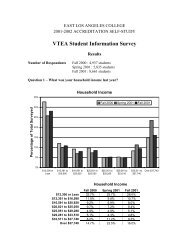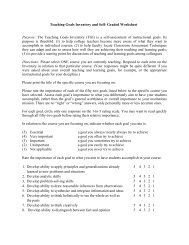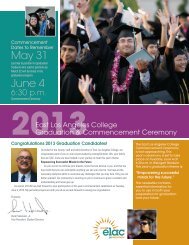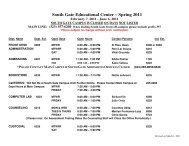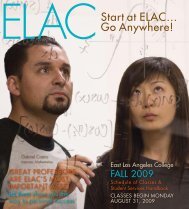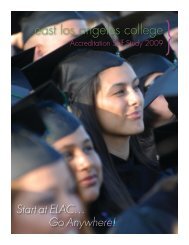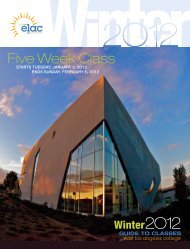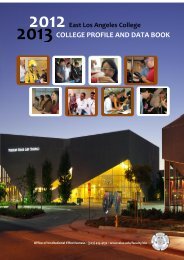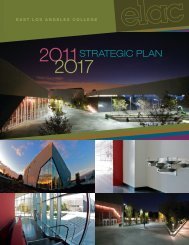ELAC Educational Master Plan - East Los Angeles College
ELAC Educational Master Plan - East Los Angeles College
ELAC Educational Master Plan - East Los Angeles College
Create successful ePaper yourself
Turn your PDF publications into a flip-book with our unique Google optimized e-Paper software.
Additionally, the committee found that completion of the English and math sequence was a substantial<br />
barrier to student success. The following data represent the impact of initial math and English placement on<br />
the overall completion of a degree, certificate or transfer program. The data indicate that students beginning<br />
lower in the English and math sequence succeed at a far lesser rate than those students placing at or able the<br />
college competency level (English 101 and Math 125).<br />
Cohort Analysis by First English<br />
First English 2008 Cohort Completions %<br />
Transfer Level 31 13 41.9%<br />
English 101 333 83 24.9%<br />
English 28/60s 614 87 14.2%<br />
English 26/57 527 58 11.0%<br />
English 21 492 35 7.1%<br />
Reading 20 275 17 6.2%<br />
ESL 384 53 13.8%<br />
Other Reading 57 3 5.3%<br />
None 1,414 68 4.8%<br />
Total 4,127 417 10.1%<br />
Cohort Analysis by First Math<br />
First Math 2008 Cohort Completions %<br />
Transfer Level 190 83 43.7%<br />
Math 120/125 420 104 24.8%<br />
Math 115 681 80 11.8%<br />
Math 110/112 1,155 79 6.8%<br />
Math 105 183 7 3.8%<br />
None 1,497 64 4.3%<br />
Other 1 0.0%<br />
Total 4,127 417 10.1%<br />
The initial success completion data led to additional analysis on the math and English sequences.<br />
Specifically, all students who took their first math course at <strong>ELAC</strong> in Fall 2008 were tracked through Spring<br />
2011 (n = 2,465). These students could be of any academic level, but must have begun their math sequence<br />
in Fall 2008. To ensure that students with different initial levels of math knowledge were not all grouped<br />
together, students were placed into cohorts based on their first math course at <strong>ELAC</strong> (i.e. Math 105, 110/112,<br />
115, 125, Transfer Level). For example, the progress of students whose first math class at <strong>ELAC</strong> was Math<br />
105 in Fall 2008 was tracked for three years. Students who began at Math 110/112 in Fall 2008 were grouped<br />
into a separate cohort and their progress was also tracked through three years. The data below illustrate<br />
success through the math sequence as a function of initial math level. In addition, the average number of<br />
attempts that students needed to pass each math course in the sequence was calculated for each cohort. It is<br />
clear from the data that a substantial number of students fail to complete the math sequence within three<br />
years and that the lower the starting point, the more likely the student is to fail to reach transfer level.<br />
Furthermore, students average nearly 1.5 attempts per level, adding significant time to completion for a large<br />
portion of the student body.<br />
8 Page <strong>Educational</strong> <strong>Master</strong> <strong>Plan</strong> 2012





